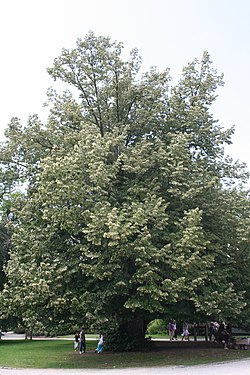Tilia tomentosa
| Habit | tree
| |
|---|---|---|
| Height: | ⇕ | 80 ft"ft" can not be assigned to a declared number type with value 80. to 100 ft"ft" can not be assigned to a declared number type with value 100. |
| Width: | ⇔ | 50 ft"ft" can not be assigned to a declared number type with value 50. |
| Lifespan: | ⌛ | perennial |
| Exposure: | ☼ | sun |
|---|---|---|
| USDA Zones: | 6 to 9 |
|
Tilia > |
Moench > |
Tilia tomentosa (Silver Lime in the UK and Silver Linden in the US) is a species of Tilia native to southeastern Europe and southwestern Asia, from Hungary and the Balkans east to western Turkey, occurring at moderate altitudes.[1][2]
It is a deciduous tree growing to 20-35 m tall, with a trunk up to 2 m diameter. The leaves are alternately arranged, rounded to triangular-ovate, 4-13 cm long and broad with a 2.5–4 cm petiole, green and mostly hairless above, densely white tomentose with white hairs below, and with a coarsely toothed margin. The flowers are pale yellow, hermaphrodite, produced in cymes of three to ten in mid to late summer with a pale green subtending leafy bract; they have a strong scent and are pollinated by honeybees. The nectar however contains sugars which cannot be digested by bumble bees, to which the tree is somewhat toxic. The fruit is a dry nut-like drupe 8–10 mm long, downy, and slightly ribbed.[1][3]
It is widely grown as an ornamental tree throughout Europe. It is very tolerant of urban pollution, soil compaction, heat, and drought, and would be a good street tree in urban areas, but for the problems it causes leaving numerous dead and comatose bumble bees on the street below the tree.[1][4]
Read about Tilia tomentosa in the Standard Cyclopedia of Horticulture
|
|---|
|
Tilia tomentosa, Moench (T. argentea, DC. T. alba, Ait. T. alba pyramidalis, Hort.). White Linden. Tree, to 100 ft. with upright branches: young branchlets stellate-tomentose: lvs. nearly orbicular, abruptly acuminate, truncate or cordate at the base, serrate or doubly serrate, often lobulate, with short-pointed teeth, sparingly pubescent above, white-tomentose beneath, 3-5 in. across; petiole pubescent, less than half of the length of the blade: fls. 7-10, in pendulous tomentose cymes: fr. ovoid, slightly 5-angled, tomentose; shell woody. July. E. Eu., Asia Minor. —This is a very handsome tree of dense habit with upright branches; it stands heat and drought better than any of the other species. Its fls. and those of the following species have proved poisonous to bees. CH
|
Cultivation
- Do you have cultivation info on this plant? Edit this section!
Propagation
- Do you have propagation info on this plant? Edit this section!
Pests and diseases
- Do you have pest and disease info on this plant? Edit this section!
Varieties
The cultivar 'Brabant' has a strong central stem and a symmetrical conic crown. The cultivar 'Petiolaris' (Pendent Silver Lime) differs in longer leaf petioles 4–8 cm long and drooping leaves; it is of unknown origin and usually sterile, and may be a hybrid with another Tilia species.[1][3]
Gallery
References
- Standard Cyclopedia of Horticulture, by L. H. Bailey, MacMillan Co., 1963
External links
- w:Tilia tomentosa. Some of the material on this page may be from Wikipedia, under the Creative Commons license.
- Tilia tomentosa QR Code (Size 50, 100, 200, 500)
- ↑ 1.0 1.1 1.2 1.3 Rushforth, K. (1999). Trees of Britain and Europe. Collins ISBN 0-00-220013-9.
- ↑ Flora Europaea: Tilia tomentosa
- ↑ 3.0 3.1 Mitchell, A. F. (1974). A Field Guide to the Trees of Britain and Northern Europe. Collins ISBN 0-00-212035-6
- ↑ Mitchell, A. F. (1996). Alan Mitchell's Trees of Britain. HarperCollins. ISBN 0-00-219972-6.



